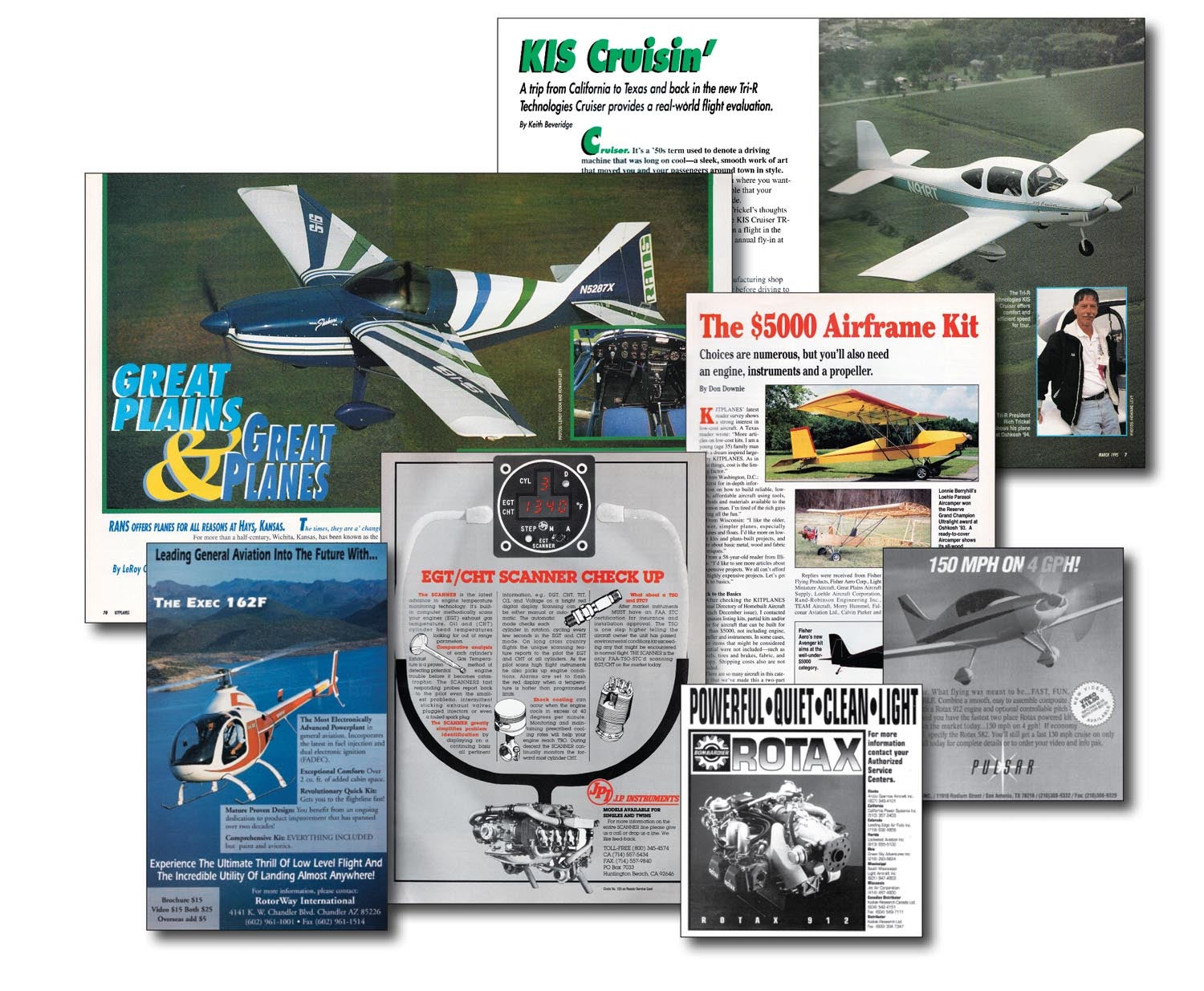 Rich Trickel’s KIS Cruiser was the subject of our March 1995 cover. KITPLANES® Managing Editor Keith Beveridge not only got to sample the TR-4 Cruiser but he flew from Trickel’s base in Camarillo, California, to Kerrville, Texas, in the airplane. And back! “KIS stands for keep it simple and the new KIS Cruiser TR-4 was designed with that in mind: Trickel and two associates built the plane in just 75 days, and he says that the average builder can finish the four-place machine in 1200–1500 hours,” Beveridge reported. The all-composite KIS used a 180-hp Lycoming O-360 and a fixed-pitch prop—remember, KIS(S). “The Cruiser handles well in adverse weather. When trimmed, it flies well hands-off. Control harmony is good: Pitch control is lighter than aileron forces, but not so much that the Cruiser is difficult to control. We were in light turbulence during many parts of the trip, and the Cruiser wasn’t difficult to keep on track.” On the last leg of the trip home, no doubt battling some headwinds, they saw an average of 139 knots over the ground at an average fuel burn of 8.5 gph. The TR-4 had a claimed 175 mph (152 knot) maximum cruise speed.
Rich Trickel’s KIS Cruiser was the subject of our March 1995 cover. KITPLANES® Managing Editor Keith Beveridge not only got to sample the TR-4 Cruiser but he flew from Trickel’s base in Camarillo, California, to Kerrville, Texas, in the airplane. And back! “KIS stands for keep it simple and the new KIS Cruiser TR-4 was designed with that in mind: Trickel and two associates built the plane in just 75 days, and he says that the average builder can finish the four-place machine in 1200–1500 hours,” Beveridge reported. The all-composite KIS used a 180-hp Lycoming O-360 and a fixed-pitch prop—remember, KIS(S). “The Cruiser handles well in adverse weather. When trimmed, it flies well hands-off. Control harmony is good: Pitch control is lighter than aileron forces, but not so much that the Cruiser is difficult to control. We were in light turbulence during many parts of the trip, and the Cruiser wasn’t difficult to keep on track.” On the last leg of the trip home, no doubt battling some headwinds, they saw an average of 139 knots over the ground at an average fuel burn of 8.5 gph. The TR-4 had a claimed 175 mph (152 knot) maximum cruise speed.

Proof that low-cost options were always on builders’ minds, we featured a number of kits whose airframe portions were around $5000—just under $10K today. Among them were the Loehle Aircamper, five Fisher kits, three kits from LMA (Light Miniature Aircraft), the KR-1 and all nine of TEAM Inc.’s kits. John Monnett’s Sonerai was there as well.
We included a two-page story by Dennis Shattuck describing how the JPI EDM-700 was the state of the art in engine monitoring. As quaint as it may seem now, the all-channel EGT/CHT analyzer was still a new thing. Insight Avionics had introduced its GEM (for graphic engine monitor) in 1981, but by the mid-1990s, we were still not convinced that the expense and complication were worth the effort. Nearly three decades of experience later, few of us who have flown with full engine monitoring would willingly go without.
LeRoy Cook spent some time with this relatively new company called RANS. Randy Schlitter had only been selling kits since 1983, but the prolific designer had already filled out the catalog with a mix of mid-wing aerobatic aircraft, high-wing utility machines and the low-wing S-11 Pursuit. While the S-6 Coyote and S-7 Courier were his bread-and-butter models, the catalog also included the S-4 and S-5 quasi-ultralights, the S-9 Chaos and S-10 Sakota mid-wing airplanes, the S-11 Pursuit, the S-12 and S-14 Airaile models and, new at the time, the S-16 Shekari. Phew.
Editor Dave Martin noted that Stoddard-Hamilton had completed the first flight of the GlaStar late in 1994. He was able to return to Redmond, Oregon, where Lancair and Express Design (owner of what had started as the Wheeler Express) were based. He described the new Lancair Super ES “as easy to fly and docile as any high-performance airplane I know.” The ES, using an unpressurized version of the Lancair IV’s four-seat cabin with a larger wing and fixed gear, eventually was certified and sold as the Columbia 300. It and the turbocharged version, the 400/TTx, became Cessnas after the Wichita company had purchased the assets of Columbia near the end of 2007.












